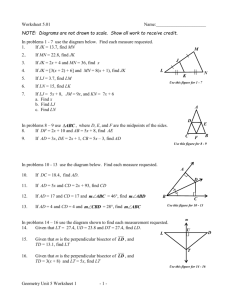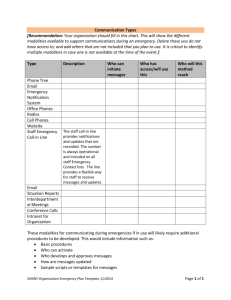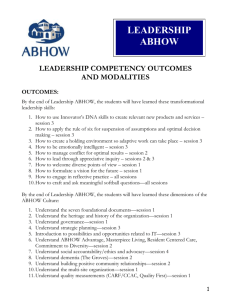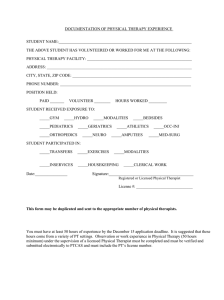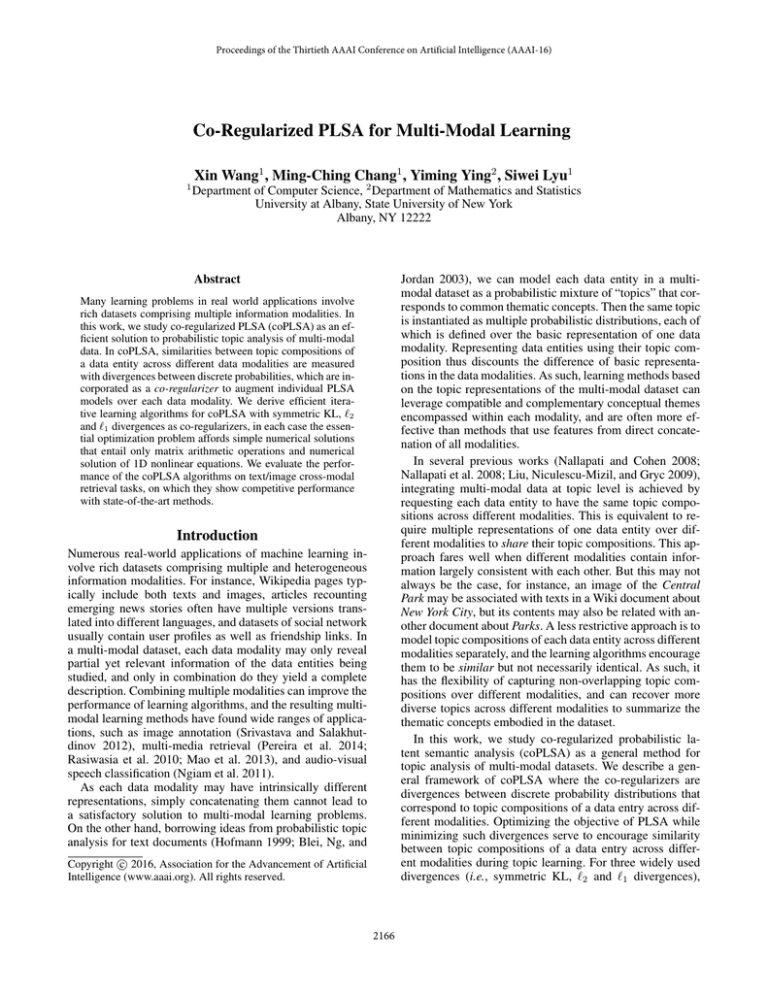
Proceedings of the Thirtieth AAAI Conference on Artificial Intelligence (AAAI-16)
Co-Regularized PLSA for Multi-Modal Learning
1
Xin Wang1 , Ming-Ching Chang1 , Yiming Ying2 , Siwei Lyu1
Department of Computer Science, 2 Department of Mathematics and Statistics
University at Albany, State University of New York
Albany, NY 12222
Jordan 2003), we can model each data entity in a multimodal dataset as a probabilistic mixture of “topics” that corresponds to common thematic concepts. Then the same topic
is instantiated as multiple probabilistic distributions, each of
which is defined over the basic representation of one data
modality. Representing data entities using their topic composition thus discounts the difference of basic representations in the data modalities. As such, learning methods based
on the topic representations of the multi-modal dataset can
leverage compatible and complementary conceptual themes
encompassed within each modality, and are often more effective than methods that use features from direct concatenation of all modalities.
In several previous works (Nallapati and Cohen 2008;
Nallapati et al. 2008; Liu, Niculescu-Mizil, and Gryc 2009),
integrating multi-modal data at topic level is achieved by
requesting each data entity to have the same topic compositions across different modalities. This is equivalent to require multiple representations of one data entity over different modalities to share their topic compositions. This approach fares well when different modalities contain information largely consistent with each other. But this may not
always be the case, for instance, an image of the Central
Park may be associated with texts in a Wiki document about
New York City, but its contents may also be related with another document about Parks. A less restrictive approach is to
model topic compositions of each data entity across different
modalities separately, and the learning algorithms encourage
them to be similar but not necessarily identical. As such, it
has the flexibility of capturing non-overlapping topic compositions over different modalities, and can recover more
diverse topics across different modalities to summarize the
thematic concepts embodied in the dataset.
In this work, we study co-regularized probabilistic latent semantic analysis (coPLSA) as a general method for
topic analysis of multi-modal datasets. We describe a general framework of coPLSA where the co-regularizers are
divergences between discrete probability distributions that
correspond to topic compositions of a data entry across different modalities. Optimizing the objective of PLSA while
minimizing such divergences serve to encourage similarity
between topic compositions of a data entry across different modalities during topic learning. For three widely used
divergences (i.e., symmetric KL, 2 and 1 divergences),
Abstract
Many learning problems in real world applications involve
rich datasets comprising multiple information modalities. In
this work, we study co-regularized PLSA (coPLSA) as an efficient solution to probabilistic topic analysis of multi-modal
data. In coPLSA, similarities between topic compositions of
a data entity across different data modalities are measured
with divergences between discrete probabilities, which are incorporated as a co-regularizer to augment individual PLSA
models over each data modality. We derive efficient iterative learning algorithms for coPLSA with symmetric KL, 2
and 1 divergences as co-regularizers, in each case the essential optimization problem affords simple numerical solutions
that entail only matrix arithmetic operations and numerical
solution of 1D nonlinear equations. We evaluate the performance of the coPLSA algorithms on text/image cross-modal
retrieval tasks, on which they show competitive performance
with state-of-the-art methods.
Introduction
Numerous real-world applications of machine learning involve rich datasets comprising multiple and heterogeneous
information modalities. For instance, Wikipedia pages typically include both texts and images, articles recounting
emerging news stories often have multiple versions translated into different languages, and datasets of social network
usually contain user profiles as well as friendship links. In
a multi-modal dataset, each data modality may only reveal
partial yet relevant information of the data entities being
studied, and only in combination do they yield a complete
description. Combining multiple modalities can improve the
performance of learning algorithms, and the resulting multimodal learning methods have found wide ranges of applications, such as image annotation (Srivastava and Salakhutdinov 2012), multi-media retrieval (Pereira et al. 2014;
Rasiwasia et al. 2010; Mao et al. 2013), and audio-visual
speech classification (Ngiam et al. 2011).
As each data modality may have intrinsically different
representations, simply concatenating them cannot lead to
a satisfactory solution to multi-modal learning problems.
On the other hand, borrowing ideas from probabilistic topic
analysis for text documents (Hofmann 1999; Blei, Ng, and
c 2016, Association for the Advancement of Artificial
Copyright Intelligence (www.aaai.org). All rights reserved.
2166
cent works (Jiang et al. 2012a; 2012b)1 . The co-regularizer
used in (Jiang et al. 2012a) is based on the mutual similarities of data in the topic space, and that of (Jiang et al.
2012b) is the 2 divergence between the topic assignments
in the latent space. The common drawback of both methods,
however, is that the optimization procedure cannot guarantee monotonic improvement of the objective function before
a stationary point is reached (we pointed out in Section 4).
As such, the algorithms in these previous works do not afford guarantees to converge and usually lead to inferior performance.
In comparison with the previous works, the main contributions of this work can be summarized as follows: (i) We
describe the general method of coPLSA based on divergence
between discrete probability distributions as co-regularizer;
(ii) for 2 divergence as co-regularizer, our coPLSA algorithm is more efficient and guarantees convergence (see Section 4 for detail); and (iii) we describe new coPLSA algorithms using symmetric KL and 1 divergences as coregularizers and demonstrate that they are more effective
than that based on 2 divergence.
we derive efficient algorithms for learning topics and topic
compositions on multi-modal datasets, all based on simple matrix operations and numerical solution of 1D nonlinear equations. Unlike previous works (Jiang et al. 2012a;
2012b), our algorithms follow the correct optimization of
the objective functions, and afford theoretical guarantee of
convergence. The coPLSA algorithms are applied to crossmodal retrieval tasks on benchmark text/image datasets, and
compared favorably with the current state-of-the-art methods.
Related Works
Many existing works on multi-modal learning are based on
seeking latent representations where the difference among
multiple modalities are minimized. Such latent representations can be directly obtained in the form of nonlinear manifolds with kernelized canonical correlation analysis (Vinokourov, Shawe-taylor, and Cristianini 2002), cross-modal factor analysis (Pereira et al. 2014), manifold alignment approach (Mao et al. 2013), joint dimension reduction (Mahadevan et al. 2011) or deep network models (Ngiam et al.
2011; Srivastava and Salakhutdinov 2012). Another popular
approach to find such joint latent representations is through
the use of co-regularized nonnegative matrix factorization
(NMF)(Jialu Liu and Han 2013; He et al. 2014). Though
each of these methods has its merits, the learned joint latent
representations usually do not afford explicit probabilistic
interpretations.
The probabilistic topic analysis of multi-modal data was
first formulated in (Cohn and Hofmann 2001), in which the
citations in a document is considered as another modality
to the documents in a corpus, and the shared topics of two
modalities are the weighted combination of the topic that
learned form the individual modalities. Subsequently, many
methods, e.g., (Nallapati et al. 2008; Rosen-Zvi et al. 2004;
Liu, Niculescu-Mizil, and Gryc 2009) were developed to
jointly model document topics and other auxiliary information provided with the corpus. However, these models all
assume that each data entity and its associated auxiliary data
share the same topic composition across different modality.
As pointed out in the previous section, this assumption may
be too restrictive when applied to real-world multi-modal
datasets that contain non-text data types such as images.
A Bayesian treatment of multi-modal topics that incorporates similarities between associated topic compositions
of different data modalities leads to a Markov random field
augmented probabilistic topic model that has been studied
recently in (Virtanen et al. 2012). Though achieving good
performances in multi-modal learning tasks, the Bayesian
MRF model suffers from increased complexity in the learning and inference algorithms that have to be implemented
with Monte-Carlo methods. Therefore, it is useful to extend
simpler topic analysis methods such as probabilistic latent
semantic analysis (PLSA) (Hofmann 1999) to multi-modal
learning, whose efficient implementation can be used for
rapid analysis of large multi-modal dataset and initializations of more sophisticated Bayesian methods.
Two specific methods of extending PLSA to multi-modal
learning with co-regularization has been studied in two re-
Review of PLSA Algorithm
We first introduce notations and definitions to be used hereafter.
d A d-dimensional vector v is stochastic if vi 0 and
i=1 vi = 1, and corresponds to a categorical probability
distribution over d outcomes. A d × n nonnegative matrix V
is stochastic if its column vectors are stochastic.
For two d-dimensional stochastic vectors v and w, we
define their Kulback-Leibler (KL), 2 and 1 divergence, in
d
sequence, as: DKL (v, w) = i=1 vi log wvii , D2 (v, w) =
d
d
1
2
i=1 (vi − wi ) , D1 (v, w) =
i=1 |vi − wi |, and
2
their symmetric KL divergence is defined as DsKL (v, w) =
DKL (v, w)+DKL (w, v). Accordingly, we define divergence
between two stochastic matrices V and W as the sum of the
divergence between their corresponding columns, as
(1)
D∗ (W, V ) = j D∗ (W·,j , V·,j ),
where D∗ can be replaced with DKL , DsKL , D2 or D1 . For
stochastic vectors/matrices, these divergences are nonnegative and equal to zero if and only if the two vectors/matrices
are identical.
Making analogy to a collection of text documents, we use
a “bag-of-word” representation of a dataset, where each data
entity (a “document”) is represented as the normalized frequencies over some basic features (“words” in a “vocabulary”). Probabilistic latent semantic analysis (PLSA) (Hofmann 1999) is based on a simple probabilistic generative
model of the dataset (Blei, Ng, and Jordan 2003): each word
in a document is a sample from a mixture model; each component of the mixture model is a categorical distributions
over the vocabulary (a “topic”); the mixing weights of the
1
Because of the close relation between PLSA and NMF algorithms (Gaussier and Goutte 2005; Ding, Li, and Peng 2008),
coPLSA can also be regarded as a co-regularized NMF problem.
However, most existing co-regularized NMF methods use 2 divergence for both main objective and co-regularizer, and do not
consider the normalization constraint.
2167
for argmaxW F(W, W (t) ), which using Eq.(3) reduces to
maxW
ik Mik log Wik , s.t. Wij 0 &
i Wij = 1.
(4)
ik
, in
The solution to this problem is given by Wik = M
M
i
k
i
which the normalization step and the non-negativity of M
assures W to be a stochastic matrix.
Optimizing H: The EM algorithm optimizing H with fixed
W proceeds similarly. First using an auxiliary stochastic matrix Ĥ we define function
Vij Wik Ĥkj
Hkj log
W Ĥ
G(H, Ĥ) =
ij
Ĥkj
W
Ĥ
ijk
ij
(5)
=
Qkj log Hkj + const,
mixture model correspond to a probability distribution over
the topics, and provides the topic composition of the data
entity.
Specifically, for n documents, (d1 , · · · , dn ), over a vocabulary of size d, (w1 , · · · , wd ), we use stochastic matrix
V of dimension d × n to represent conditional probabilities,
as Vij ≡ Prob(word = wi |doc = dj ). Assuming the documents are associated with m topics, (t1 , · · · , tm ), we use
stochastic matrices W of dimension d × m and H of dimension m × n to represent conditional probabilities, as Wik ≡
Prob(word = wi |topic = tk ) and Hkj ≡ Prob(topic =
tk |doc = dj ), respectively. According to the document generation model, documents and words are conditionally independent from each other. As such, these
probabilities satisfy Prob(word = wi |doc = dj ) =
k Prob(word =
wi |topic = tk )Prob(topic = tk |doc = dj ). With the
matrix notations, this is equivalent to V = W H. Given a
dataset represented in matrix V , PLSA attempts to find its
decomposition into W and H, formulated as an optimization problem: minW,H DKL (V, W H), with the constraint
that both W and H are stochastic matrices. After dropping
irrelevant constant terms, minimizing the KL divergence is
equivalent to maximizing
(2)
J (W, H) = ij Vij log(W H)ij .
kj
with matrix Q = Ĥ ⊗ W T (V (W Ĥ)) . With a similar argument, we can show that G(H, Ĥ) is also a tight
lower-bound of J (W, H), on the basis of which the EM algorithm is obtained. Specifically, each step of the EM algorithm solves
maxH
kj Qik log Hkj , s.t. Hkj 0 &
k Hkj = 1,
(6)
Q
of which the solution is given by Hkj = kj
.
Q This optimization problem can be solved with block coordinate ascent by iteratively optimizing W or H while fixing
the other until converging to a local optimum. The individual optimization step for W and H is solved with the EM
algorithm. To facilitate subsequent discussion, we briefly
review the EM algorithm using the matrix notations introduced early in this section.
Optimizing W : Introducing a different stochastic matrix
Ŵ , we first define an auxiliary function
Vij Ŵik Hkj
Wik log
Ŵ H
F(W, Ŵ ) =
ij
Ŵik
Ŵ H
ijk
ij
(3)
=
Mik log Wik + const.
k
k j
The coPLSA Algorithm
In coPLSA, our goal is to perform joint PLSA of a multimodal dataset across different modalities, based on the assumption that different data modalities admit similar underlying semantic structure of the data. Formally, given two
modalities of the dataset2 represented with stochastic matrices V (1) and V (2) of size d1 × n and d2 × n, we seek factorization V (l) ≈ W (l) H (l) , with stochastic matrices W (l) of
size d × m and matrix H (l) of size m × n representing the
m modality-specific topic matrices and the topic compositions of the dataset, respectively. In coPLSA, association of
different modalities to their common data entry is achieved
by coupling the factorizations V (l) ≈ W (l) H (l) , i.e., besides
individual PLSA objectives to each modality, the algorithm
also introduce co-regularizers to minimize the difference of
H matrices, corresponding to the topic compositions of each
modality (illustrated in the left panel of Fig.1). Specifically,
coPLSA is formulated as a constrained optimization problem as
DKL (V (l) , W (l) H (l) ) + λD∗ (H (1) , H (2) ),
min
ik
In the last step, terms irrelevant to W are collected
into a constant. Nonnegative matrix M = Ŵ ⊗
(V (Ŵ H))H T is formed with element-wise matrix
multiplication ⊗ and division . An application of the
Jensen’s inequality shows that F(W, Ŵ ) J (W, H) with
equality holds when W = Ŵ , i.e., F(W, Ŵ ) is a tight
lower-bound of J (W, H).
The EM algorithm optimizing W uses this lower-bound
to improve the objective function in an iterative manner:
Starting with an initial values W = W (0) , we iteratively
solve for W (t+1) ← argmaxW F(W, W (t) ) with the constraint W being stochastic. As we have J (W (t) , H) =
F(W (t) , W (t) ) F(W (t+1) , W (t) ) J (W (t+1) , H),
the sequence (W (0) , W (1) , · · · ) monotonically increases
J (W, H) until reaching a local maximum.
During each iteration step of the EM algorithm, we solve
W () ,H ()
=1,2
(7)
with the constraint that W (l) and H (l) are stochastic matrices. Parameter λ > 0 balances the contribution of the
PLSA objectives of each modality and the co-regularization
term. In the following, D∗ will be replaced with the symmetric KL, 2 or 1 divergences3 . Dropping irrelevant constant
2
The algorithm described subsequently can be easily extended
to more than two data modalities.
3
It is also possible to incorporate other regularization terms on
the factors W (l) and H (l) to express other preference on the factors
2168
n
m
n
d1
V (1)
≈ W (1) ×
H (1)
Initialize W (1) , W (2) , H (1) , H (2) ;
While not converge
While not converge
≈
update W (l) using Eq.(4);
d2
V (2)
≈ W (2) ×
While not converge
If D∗ = DsKL , update H (l) with (11) and (14);
H (2)
If D∗ = D2 , update H (l) with (12) and (14);
If D∗ = D1 , update H (l) with (13) and (14);
Figure 1: Left: Illustration of coPLSA as two stochastic matrix factorization problems co-regularized through similarities on
factors. Right: Pseudo-code of the coPLSA algorithm in this work.
we iteratively solve for
terms, the objective function of (7) can be further simplified
to
J (W (l) , H (l) ) − λD∗ (H (1) , H (2) ), (8)
max
W () ,H ()
H (l,t+1) ← argmax G(H (l) , H (l,t) ) − λD∗ (H (l) , H (\l) ),
H (l)
(l)
s.t. Hkj 0 &
=1,2
(l)
Hkj = 1.
k
with the same constraints on the factors.
As in the case of PLSA, in the learning step of coPLSA,
the objective function in (8) is optimized with a blockcoordinate descent scheme, alternating between steps that
optimizing each of W (1) , W (2) , H (1) or H (2) while fixing
the other factors. In the following, we describe the steps of
these sub-problems.
Optimizing W (l) : The step optimizing each W (l) is the
same as the optimization of W in PLSA. As such, the solution can be obtained via solving a sequence of optimization
problem given in (4).
Optimizing H (l) : The optimization of H (l) is different because of the co-regularizer. For simplicity, we use H (\l) to
denote the other H factor other than H (l) . The optimization
of H (l) with fixed W (l) and H (\l) , after removing irrelevant
constant terms, becomes
(9)
In each iteration, it is guaranteed that the objective function
will not be decreased, as
J (W (l) , H (l,t) ) − λD∗ (H (l,t) , H (\l) ) = G(H (l,t) , H (l,t) )−
λD∗ (H (l,t) , H (\l) ) G(H (l,t+1) , H (l,t) ) − λD∗ (H (l,t+1) ,
H (\l) ) J (W (l) , H (l,t+1) ) − λD∗ (H (l,t+1) , H (\l) ).
As such, the sequence H (l,0) , H (l,1) , · · · monotonically increases the objective function J (W (l) , H (l) ) −
λD∗ (H (l) , H (\l) ) until reaching a local minimum.
Solving the optimization problem in (9) is key to the optimization. For the 2 co-regularizer, a method is given in
(l)
(Jiang et al. 2012b), where one first updates Hkj using the
(l)
PLSA EM step, Eq.(6), followed by another update of Hkj
to decrease λD2 (H (l,t) , H (\l) ). Unfortunately, the two update steps may undo the effect of each other as they are performed independently. As such, there is no clear guarantee
that the overall algorithm will converge or converge to the
optimal solution.
In this work, we provide efficient algorithms for symmetric KL, 2 and 1 divergences with convergence guarantees. Using the equivalent matrix definition of function G in
Eq.(5) with Q obtained from V (l) , W (l) and Ĥ, the essential
optimization problem we need to solve is
(l)
Qkj log Hkj − λD∗ (H (l) , H (\l) ),
max
max J (W (l) , H (l) ) − λD∗ (H (l) , H (\l) ),
H (l)
(l)
(l)
Hkj = 1.
s.t. Hkj 0 &
k
Using the auxiliary function G defined in Eq.(5), we can
also obtain a tight lower-bound of the above objective function, as: G(H (l) , Ĥ)−λD∗ (H (l) , H (\l) ) J (W (l) , H (l) )−
λD∗ (H (l) , H (\l) ) with equality when Ĥ = H (l) , which follows from the property of G. Note that in this lower-bound,
the second term λD∗ (H (l) , H (\l) ) does not depend on the
auxiliary variable Ĥ.
Then, a similar EM algorithm can be developed to optimize H (l) iteratively, which improves the lower-bound in
each iteration: starting with an initial values H (l) = H (l,0) ,
H (l)
kj
(l)
s.t. Hkj 0 &
(l)
Hkj = 1.
(10)
k
With respect to three types of co-regularizer, namely, symmetric KL, 2 and 1 divergences, the optimal solution to
(10) are given as non-linear functions of a scalar variable ηj
that corresponds to the Lagrangian multiplier of the normal
(l)
izing constraint, k Hkj = 1 and is shared by all elements
such as sparsity. Furthermore, we can us similar methods to enforce
consistencies in parts of factor W (l) . However, for simplicity, in the
current work we do not consider these types of regularizers.
2169
image
topic composition
tags
image
topic composition
tags
New, york, city,
Unite, largest, State,
high, metropolitan,
Manhattan, world
water, lake
pond, surface
stream, basin, ice
flow, wave
town, house,
area, village, urban,
tree, room, local,
home, settlement
tree, plant, root,
sap,forest, leave,
layer, fruit,
growth, timber
building, construct,
structure, design,
city, built, sustain,
home, public
forest, tree, Forb,
taiga, tropic, climat,
season, plant, region,
broadleaf, nature,
Figure 2: Illustrating images with their annotation and topic proportion.
(l)
in one column of H (l) . Specifically, these solutions are given
in the following equations:
• For D∗ = DsKL ,
We use Hkj (ηj ) in Eqs.(11,12,13) to emphasize the fact that
they are functions of the scalar parameter ηj . To determine
the value of ηj , which in turn leads to the optimal solution
to H (l) , we can solve the following 1D nonlinear equation
corresponding to the normalization constraint in (10),
(l)
(14)
k Hkj (ηj ) = 1.
(\l)
(l)
Hkj (ηj ) =
λW0
Qkj +λHkj
(\l)
kj
(\l)
λH
kj
Qkj +λH
exp(1+
ηj
λ
)
,
(11)
where W0 (·) is the principal branch of the Lambert W
function (Corless et al. 1996) that is defined implicitly as
z = W (z)eW (z) for z > 0 4 .
• For D∗ = D2 ,
(l)
Hkj (ηj )
=
1
2
(\l)
Hkj −
ηj
λ
2
+
4Qkj
λ
+
1
2
(\l)
Hkj −
ηj
λ
For each type of co-regularizers, we use the correspond(l)
ing Hkj (ηj ) in Eq.(11,12,13). For each column index j,
Eq.(14) is solved numerically, e.g., with Newton-Raphson
(l)
when Hkj (ηj ) is differentiable (e.g., D∗ = D2 or DsKL ) or
bi-section when otherwise (e.g., D∗ = D1 ).
In summary, we solve the coPLSA problem with an iterative algorithm that alternates between the optimization of
individual W and H factors while fixing the others. The optimization of W factor is performed with another iterative
EM algorithm based on individual optimization steps given
in (4), and the optimization of H factor is achieved by iterating steps that first solve Eq.(14) and then determine the
factors with Eq.(11), (12) or (13). In practice, all iterative
algorithms converges within 5-10 steps. The right panel of
Fig.1 provides the pseudo-code of the overall algorithm.
.
(12)
• For D∗ = D1 ,
⎧ Qkj
⎪
ηj +λ ,
⎪
⎪
⎨ (\l)
(l)
Hkj ,
Hkj (ηj ) =
⎪
⎪
⎪
⎩ Qkj ,
ηj −λ
−λ < ηj <
Qkj
Qkj
(\l)
Hkj
(\l)
− λ ηj (\l)
+ λ < ηj .
Hkj
Qkj
Hkj
− λ,
Qkj
(\l)
Hkj
+ λ,
(13)
Compared with the two other divergence types, the update steps for 1 divergence in Eq.(13) corresponds to
a piecewise function. The computation only involves
arithmetic operations and thresholding, and is substantially simpler and more efficient. The use of 1 coregularizer has another important property that the resulting H (l) can have identical components as H (\l) ,
while for the 2 and symmetric KL co-regularizers, this
is not usually the case.
Application to Cross-Modal Retrieval
One important multi-modal learning task is cross-modal
Text/Image retrieval. With the proliferation of online multimodal data (Wikipedia, Youtube, etc), queries are frequently
made in one modality (e.g., image or videos) with input from
another modality (e.g., texts). In this section, we apply the
coPLSA algorithms to cross-modal retrieval tasks involving documents containing text and images. Specifically, we
consider two tasks: text retrieval from an image query (i2t),
and image retrieval from a query with a text document (t2i).
With the coPLSA model, the difference in basic data representations of text and images are encapsulated into the corresponding topics. And with their topic compositions, texts
The Lambert W function can be numerically evaluated and
is provided in popular numerical tools such as MATLAB (function
lambertw) or SciPy (function scipy.special.lambertw).
It has been used in algorithms that enforce entropic priors (Brand
1999). It also appears in a variant of PLSA to encourage sparsity
over the obtained W or H factors (Shashanka, Raj, and Smaragdis
2007).
4
2170
Methods
SCM (Pereira et al. 2014)
Link PLSA (Cohn and Hofmann 2001)
1 coPLSA
2 coPLSA
sKL coPLSA
Topic space similarity
TVGraz
Wikipedia
i2t
t2i
i2t
t2i
0.460 0.450 0.267 0.219
0.349 0.349 0.247 0.247
0.359 0.365 0.317 0.307
0.450 0.445 0.360 0.358
0.481 0.481 0.413 0.413
Semantic space similarity
TVGraz
Wikipedia
i2t
t2i
i2t
t2i
0.664 0.649 0.362 0.273
0.803 0.803 0.605 0.605
0.723 0.726 0.667 0.658
0.846 0.845 0.706 0.701
0.850 0.850 0.726 0.724
Table 1: Performances of multi-modal learning methods measured by the mean average precision on two text/image datasets.
the retrieved text/image is from the same semantic category
as the image/text used in query.
Table 1 summarizes the overall performances of coPLSA
algorithms with symmetric KL, 2 and 1 co-regularizers
on the two datasets. For comparison, we also include retrieval performance based on a link-PLSA model that requires the topic compositions of associated text and image to
be identical. The link-PLSA algorithm can be implemented
as described in (Cohn and Hofmann 2001). Furthermore,
all results were compared to a baseline established by the
method of semantic correlation matching (SCM) (Pereira
et al. 2014), which represents the state-of-the-art performance in text/image cross-modal retrieval tasks. Results in
Table 1 suggests that for the two cross-modal retrieval tasks,
coPLSA algorithms in general achieve better performance
than the link PLSA algorithm, and also outperform the SCM
method that is based on kernel canonical correlation analysis. This may be attributed to, on the one hand, the more
semantic relevance of the representation (as probability mixture of thematic topics of the text/images) obtained with
coPLSA, and on the other hand, its less restrict assumption
that allows for mis-match of topic compositions of associated text and images. This is further corroborated by observing that the MAP scores for i2t and t2i tasks are similar with
coPLSA algorithms, suggesting the diminished representational difference between the two modalities in the topic
space found by coPLSA. Furthermore, all three variants of
the coPLSA algorithms achieves better performance and efficient computation, but symmetric KL co-regularizer leads
to the best overall performance. Last, combining with more
semantic abstraction, as concluded in (Pereira et al. 2014),
can also significantly improve the retrieval performance.
In Fig.2 we further show several test images from the
Wikipedia dataset with their corresponding topic compositions over a subset of topics obtained with the symmetric
KL coPLSA algorithm (the names of each topic is manually
assigned based on the top words from each topic to facilitate understanding), together with text tags that are generated by sampling from the topic mixtures associated with
each image. The visualized topic compositions and the generated text tags of these images obtained with coPLSA span
wide semantic ranges, and can shed some light on their effects in improving the precisions of semantic matching with
the queried text document.
and images are projected into a compatible semantic space,
which can be used to establish links between images and text
documents and facilitates cross-modal retrieval.
We use two benchmark text/image datasets in our experiments: TVGraz (Khan, Saffari, and Bischof 2009) and
Wikipedia (Rasiwasia et al. 2010), in which images are associated with long text documents and the texts and images
do not necessarily have direct correspondence as in the case
of image tagging tasks (Hwang and Grauman 2012; Gong
et al. 2014). The TVGraz dataset contains 2058 text/image
pairs of 10 semantic categories with an average document
length of 289 words, and is split into a training set of 1558
text/image pairs and a testing set of 500 text/image pairs.
The Wikipedia dataset contains by 2866 text/image pairs of
30 semantic categories, and is split into training and testing
sets with 2173 and 693 text/image pairs. Images and texts in
both datasets are converted to bag-of-word representation,
where for images we used 1024 visual keywords as a result
of clustering the SIFT features from all training images, and
6203 unique text words were selected after stemming and
removal of the common stop words.
In the learning phase, we determine modality-specific topics using the coPLSA learning algorithm on the training sets.
We extract 50 topics from the TVGraz dataset and 100 topics from the Wikipedia dataset, and choose the balance parameter λ in coPLSA algorithms with cross-validation on a
subset of the training data. When performing retrieval tasks
on the testing set, we first recover the topic composition of
the queried image or text using the PLSA algorithm (only
the optimization of H matrix) using the learned modalityspecific topics. The similarities between topic compositions
of the queried image and texts in testing set (in task i2t)
or queried text and images in testing set (in task t2i) are
then evaluated and ranked. Two similarity measures are used
in our experiments, the centered normalized correlation between the topic compositions and the centered normalized
correlations between topic compositions transformed by a
multi-class logistic regression function learned during training, which maps topic compositions to the semantic categories pre-defined for each dataset. As such, the former evaluates correlations of topic compositions directly, while the
latter can be regarded as the correlation in a more semantically meaningful space induced from the topic compositions (Pereira et al. 2014). We use the mean average precision (MAP) scores over all testing data as performance
metric. The average precision score for each query is computed as the mean precision value for the top 10 relevant
retrievals. Here, we determine a relevant retrieval occurs if
Conclusions
We study co-regularized PLSA (coPLSA) for topic analysis of multi-modal data and derive efficient iterative learning
2171
algorithms for coPLSA with three types of divergences as
co-regularizers, in each case the essential optimization problem affords simple solutions that entail only matrix arithmetic operations and numerical solution of 1D nonlinear
equations. We evaluate the performance of the proposed
coPLSA algorithms on cross-modal retrieval tasks involving
text/image documents and show competitive performance
with state-of-the-art methods. In future work, we can extend
the coPLSA algorithms to more than two data modalities,
and to datasets in which each data entity may not associate
with all modalities.
Jiang, Y.; Liu, J.; Li, Z.; and Lu, H. 2012b. Collaborative PLSA
for multi-view clustering. In International Conference on Pattern Recognition.
Khan, I.; Saffari, A.; and Bischof, H. 2009. Tvgraz: Multimodal learning of object categories by combining textual and
visual features. In AAPR Workshop, 213–224.
Liu, Y.; Niculescu-Mizil, A.; and Gryc, W. 2009. Topic-link lda:
Joint models of topic and author community. In ICML, ACM
International Conference Proceeding Series, 84. ACM.
Mahadevan, V.; Wah Wong, C.; Costa Pereira, J.; T. Liu, T.; Vasconcelos, N.; and K. Saul, L. 2011. Maximum Covariance Unfolding: Manifold Learning for Bimodal Data. In Advances in
Neural Information Processing Systems, 918–926.
Mao, X.; Lin, B.; Cai; He, X.; and Pei, J. 2013. Parallel field
alignment for cross media retrieval. In Proceedings of the 21st
ACM International Conference on Multimedia, MM ’13, 897–
906.
Nallapati, R., and Cohen, W. 2008. Link-PLSA-LDA: A new
unsupervised model for topics and influence in blogs. In Association for the Advancement of Artificial Intelligence, 84 – 92.
Nallapati, R.; Ahmed, A.; Xing, E. P.; and Cohen, W. W. 2008.
Joint latent topic models for text and citations. In Knowledge
Discovery and Data Mining, 542–550. ACM.
Ngiam, J.; Khosla, A.; Kim, M.; Nam, J.; Lee, H.; and Ng, A. Y.
2011. Multimodal deep learning. In International Conference
on Machine Learning (ICML).
Pereira, J. C.; Coviello, E.; Doyle, G.; Rasiwasia, N.; Lanckriet, G. R.; Levy, R.; and Vasconcelos, N. 2014. On the role
of correlation and abstraction in cross-modal multimedia retrieval. IEEE Transactions on Pattern Analysis and Machine
Intelligence 36:521–535.
Rasiwasia, N.; Costa Pereira, J.; Coviello, E.; Doyle, G.; Lanckriet, G.; Levy, R.; and Vasconcelos, N. 2010. A New Approach
to Cross-Modal Multimedia Retrieval. In ACM International
Conference on Multimedia, 251–260.
Rosen-Zvi, M.; Griffiths, T. L.; Steyvers, M.; and Smyth, P.
2004. The author-topic model for authors and documents. Uncertainty in Artificial Intelligence.
Shashanka, M.; Raj, B.; and Smaragdis, P. 2007. Sparse overcomplete latent variable decomposition of counts data. In Platt,
J.; Koller, D.; Singer, Y.; and Roweis, S., eds., Advances in Neural Information Processing Systems 20. 1313–1320.
Srivastava, N., and Salakhutdinov, R. 2012. Multimodal learning with deep Boltzmann machines. In Advances in Neural Information Processing Systems 25, 2231–2239.
Vinokourov, A.; Shawe-taylor, J.; and Cristianini, N. 2002. Inferring a semantic representation of text via cross-language correlation analysis. In Advances in Neural Information Processing
Systems.
Virtanen, S.; Jia, Y.; Klami, A.; and Darrell, T. 2012. Factorized
multi-modal topic model. Uncertainty in Artificial Intelligence.
Acknowledgement
This work is supported by US National Science Foundation Research Grant (CCF-1319800) and National Science
Foundation Early Faculty Career Development (CAREER)
Award (IIS-0953373).
References
Blei, D. M.; Ng, A. Y.; and Jordan, M. I. 2003. Latent dirichlet
allocation. volume 3, 993–1022. Journal of Machine Learning
Research.
Brand, M. 1999. Pattern discovery via entropy minimization. In
In Uncertainty 99: AISTATS 99.
Cohn, D., and Hofmann, T. 2001. The missing link - a probabilistic model of document content and hypertext connectivity.
In Advances in Neural Information Processing Systems.
Corless, R. M.; Gonnet, G. H.; Hare, D. E. G.; Jeffrey, D. J.; and
Knuth, D. E. 1996. On the lambert w function. In Advances in
Computational Mathematics, 329–359.
Ding, C.; Li, T.; and Peng, W. 2008. On the equivalence between non-negative matrix factorization and probabilistic latent
semantic indexing factorization. Computational Statistics and
Data Analysis 52:3913–3927.
Gaussier, E., and Goutte, C. 2005. Relation between PLSA and
NMF and implications. In Special Interest Group on Information Retrieval, 601–602.
Gong, Y.; Ke, Q.; Isard, M.; and Lazebnik, S. 2014. A
multi-view embedding space for modeling internet images, tags,
and their semantics. International Journal of Computer Vision
106(2):210–233.
He, X.; Kan, M.-Y.; Xie, P.; and Chen, X. 2014. Commentbased multi-view clustering of web 2.0 items. In International
Conference on World Wide Web.
Hofmann, T. 1999. Probabilistic latent semantic analysis. In
Association for Uncertainty in Artificial Intelligence, 289–296.
Hwang, S. J., and Grauman, K. 2012. Learning the relative importance of objects from tagged images for retrieval and crossmodal search. International Journal of Computer Vision 134–
153.
Jialu Liu, Chi Wang, J. G., and Han, J. 2013. Multi-view clustering via joint nonnegative matrix factorization. In SIAM Data
Mining Symposium.
Jiang, Y.; Liu, J.; Li, Z.; Li, P.; and Lu, H. 2012a. Co-regularized
PLSA for multi-view clustering. In Asian Conference on Computer Vision.
2172

